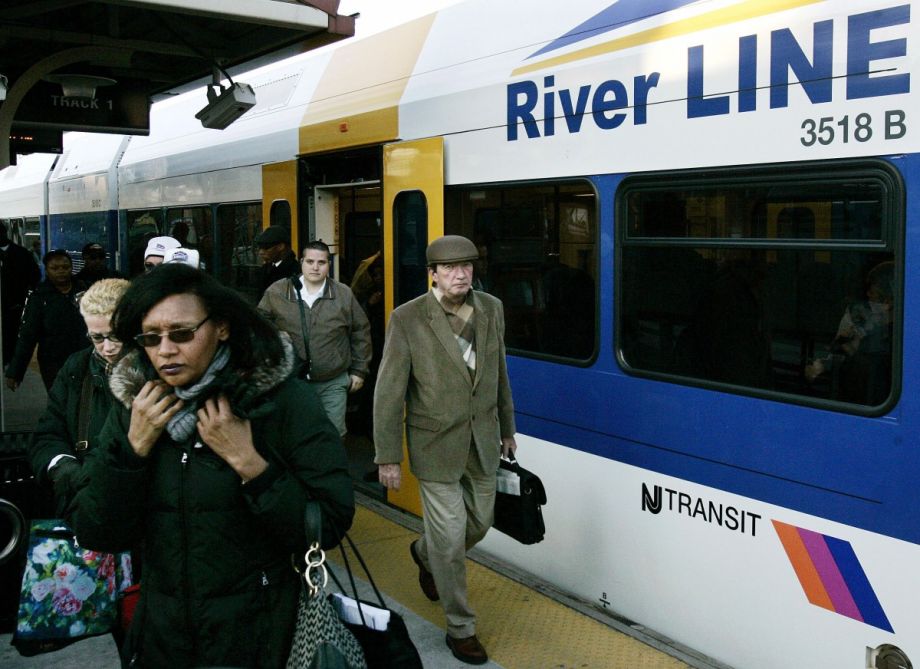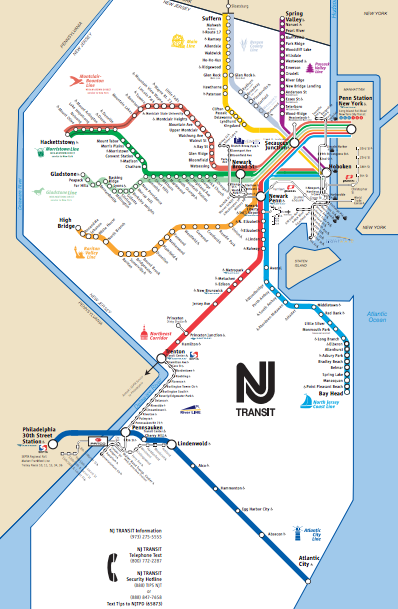Look at a map of the NJ Transit rail system, and you’ll see that the northern half of the state, in New York’s orbit, is crowded with rail lines. The south, Philadelphia’s orbit, just has one lonely rail line to Atlantic City. But that map is actually a little deceiving. The bones of a pretty good system exist, including the River Line from Camden to Trenton, and PATCO, which is run by the Delaware River Port Authority and shuttles daily commuters in and out of Philadelphia. The existing infrastructure is sound, and there is even talk of a new line from Glassboro to Camden and, more fantastically, a resurrection of the routes that used to connect the shore towns, and Atlantic City with its downbeach neighbors.
But while it is tempting to fantasize about more rail lines, there are also a lot of substantially easier and cheaper fixes that could strengthen the infrastructure as it currently exists. A lot of people disdain public transit because they hate waiting and because, too often, transit officials have not made the process of buying a ride as easy as it could and should be. Here are a few recommendations to give South Jersey the transit it deserves, grow ridership, and lure people away from their cars.1. Make the Atlantic City rail line’s schedule commuter-friendly.
Want to use NJ Transit’s principal rail route in South Jersey to get to work from Philly in the morning? Too bad. It isn’t going to happen. Between 6:31 and 8:59 there are no trains leaving Philadelphia. It is literally impossible to get anywhere on the line by 9 a.m. unless you feel like hauling yourself out of bed only to wait around for at least 30 minutes before work begins. Going from A.C. to Philly is just as bad, with trains leaving at 6:40 and 8:53.
There are other bizarre gaps in the schedule, although none as impressively nonsensical as rendering the Atlantic City line unusable for morning commuters. Usually regional rail is set up to only accommodate suburbanites traveling to work during conventional hours. That’s an unambitious way to run as transit system — rail transit can be used for all sorts of purposes, if the schedule is accommodating — but it makes a kind of sense.
It turns out that the Atlantic City line’s seemingly haphazard schedule is meant to serve the same purpose, but only for casino workers. “Along the Atlantic City line we try to match the rail schedule of workers gong to and from their shifts,” says Nancy Snyder, press representative for NJ Transit.Catering only to the admittedly odd hours of casino workers is a great way to keep ridership low. (The line is the weakest performer of all in NJ Transit’s system). And as New Jersey’s casino industry fades, and more jobs are lost, other ridership bases will be required. Commuters going to Philadelphia in the morning, for example, who will need to get there closer to 9 a.m. Then towns that host stations could promote their convenience to Center City Philly, and upzone around the stations accordingly.
“I’m hoping as we increase population as well as jobs, that it would make sense for NJ Transit to increase service,” says Don Guardian, Atlantic City’s new mayor. “That’s a no brainer. It’s certainly convenient when it is the right time, but it’s a crazy schedule.”
2. Increase service frequency.
The real problem isn’t just weird hours, but that the Atlantic City line is run infrequently. This is a common affliction. Transit officials rightly note that Americans are wedded to their cars and ask: Why run the trains and buses frequently if no one wants to ride them?
“It needs customer demand,” says Snyder. “We review our timetables quarterly and we try to match seats to demand. We constantly monitor commuting trends, economic and population growth around the state and keep a very close watch on it and we refine our schedules accordingly.”
But demand would be higher if trains and buses came more often. Given the way NJ Transit currently operates the Atlantic City line, and most of its buses, a simple ride to a friend’s house requires the kind of strategic acumen usually reserved for plotting a surprise ground invasion. As long as it is hard to ride transit, ridership will remain depressed.
The same truth holds for buses, but more so. No one likes standing around waiting, in the dark, by themselves. “The buses in South Jersey are laughably infrequent and have terrible hours,” Collingswood resident and transit blogger Joseph Russell told me in an email. “You basically cannot rely on a bus to get you around because missing one is so punishing.”
3. Introduce easy (and free) transfers among SEPTA, PATCO and NJ Transit.
The Philadelphia region enjoys excellent rail coverage, and there are numerous points of intersection among them, especially for PATCO and SEPTA riders. Yet transferring is obnoxious. PATCO’s Freedom Card doesn’t allow access to SEPTA which, of course, still has no card at all and forces everyone without weekly or monthly passes to pack tokens.
This dream of free and easy transfers is hindered, in large part, by SEPTA’s lethargic implementation of the new payment technologies. But eventually SEPTA’s card service will arrive, and although the seas will be of blood and the skies of fire, the surviving ridership should be allowed to access PATCO with a swipe of a SEPTA card. Ideally, transfers would be free, which would make transit all the more alluring, and better integrate PATCO into the regional network. New Yorkers don’t pay more to ride from Upper Manhattan to South Brooklyn, and Philadelphians shouldn’t have to pay twice for a ride from West Philly to Cherry Hill. (Also, PATCO needs to allow people to purchase one-ride tickets with a credit card. It’s annoying as hell to get down there, with only a $20 in your wallet, and watch as your bill is turned into a shower of coinage.)
The purpose of mass transit should be to provide a workable, cheap alternative to car travel. Until a potential rider can try to catch a train or bus without the threat of cooling their heels for an hour, mass transit in South Jersey will be a commuter service (PATCO) and an oddity (NJ Transit), when it could be so much more.
The Works is made possible with the support of the Surdna Foundation.



















